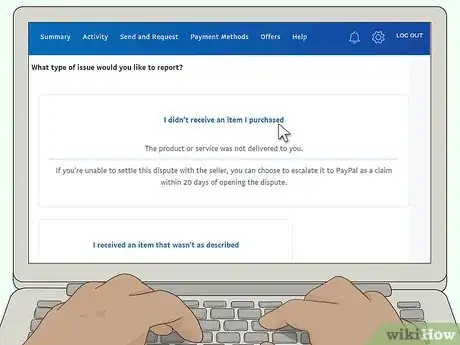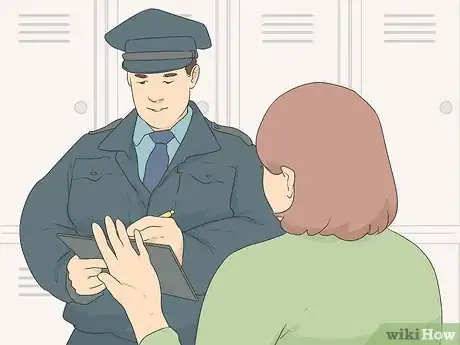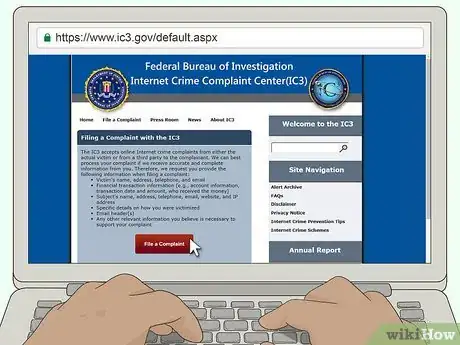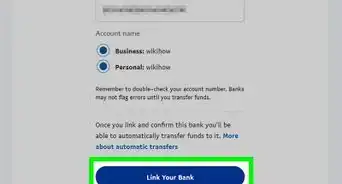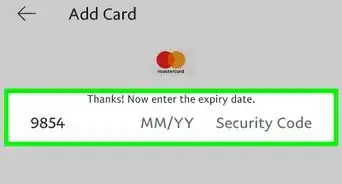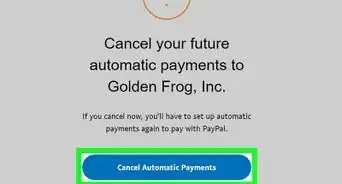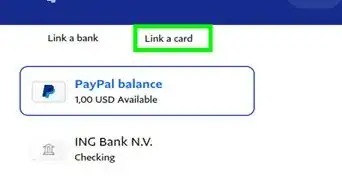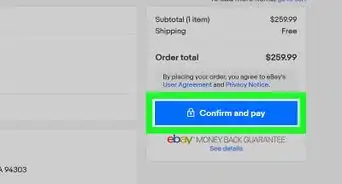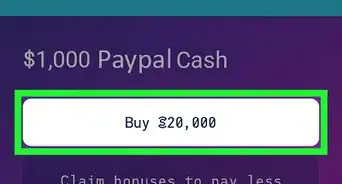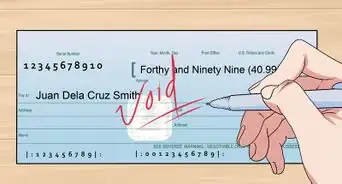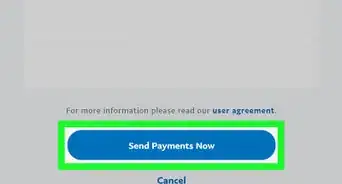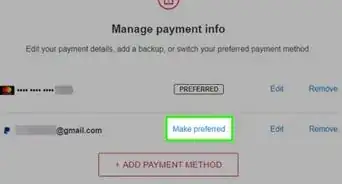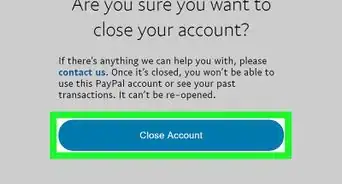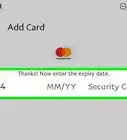This article was written by Jennifer Mueller, JD. Jennifer Mueller is an in-house legal expert at wikiHow. Jennifer reviews, fact-checks, and evaluates wikiHow's legal content to ensure thoroughness and accuracy. She received her JD from Indiana University Maurer School of Law in 2006.
There are 7 references cited in this article, which can be found at the bottom of the page.
This article has been viewed 39,694 times.
PayPal provides a more secure option to transfer money online. Unfortunately, dishonest people have also found ways to use PayPal for fraud. They take advantage of the fact that you trust PayPal to scam you out of money or items you're selling online. If you've been the victim of fraud, there is a way to report that fraud to PayPal as well as your local law enforcement. While the fraudster may not be brought to justice, you can minimize your own loss and protect your account from further fraud.
Steps
Notifying PayPal
-
1Go to the PayPal Resolution Center. Log into your PayPal account, then click on the Resolution Center link at the bottom of the page. On the page for the Resolution Center, click "Report a Problem."[1]
- The Resolution Center will show you a list of transactions that you can dispute. You can only dispute transactions that occurred in the last 180 days.[2]
-
2Select the transaction you want to dispute. From the list of available transactions, find the fraudulent transaction that you want to dispute and highlight it. If you only have one transaction you want to dispute, click "Continue."[3]
- You'll have options to tell PayPal the type of dispute you want to create. For example, if you had an unauthorized transaction on your PayPal account, you would select "I want to report unauthorized activity."
- Once you've found the most accurate description, click "Continue."
Advertisement -
3Provide a description of your problem. Follow the instructions to tell PayPal as much information as possible about the transaction and the fraud you believe the other person committed or attempted to commit. Be as detailed as possible.[4]
- If you have a link to an eBay listing, include that along with your dispute. Copy any emails or messages you received or sent to the other person.
- For example, if a teenager used a credit card or PayPal account without the owner's permission to commit fraud, you might have emails with the true owner of the account.
-
4Escalate your dispute to a claim. After you file your dispute, PayPal gives you 20 days to attempt to resolve the dispute with the other person. However, if you know the transaction was fraudulent, you don't need all that time. Instead, escalate the dispute to a claim so PayPal will start an investigation.[5]
- You may have to wait 7 days before you can claim fraud on PayPal.
Tip: Once you've escalated your dispute, PayPal resolves most fraud claims within 10 to 14 days.
-
5Forward spoof emails to PayPal's dedicated email address. Even with the strongest spam filter, you may still see emails from fraudsters pretending to be PayPal. They may have realistic-looking logos and other information, and typically claim that your account has been compromised. They hope that you'll follow the link in the email and provide your account information.[6]
- If you get an email that you suspect is a spoof, forward it to spoof@paypal.com. Never follow any links in an email. PayPal itself won't require you to follow a link or provide your account information, and PayPal will never ask you for your password.
Alerting Law Enforcement
-
1Gather information about the fraudulent transaction. All of the details you have about the transaction, including any communication you had with the fraudsters, will help law enforcement find the culprit. If you have any contact information for the fraudsters, write that down as well.[7]
- If you exchanged emails with the fraudster, keep the original emails. There is information in the headers that law enforcement can use to track the person who sent the email.
-
2File a police report with your local police department. If someone defrauds you out of money or an item you were trying to sell online, call a police non-emergency number or go to the nearest precinct in person and tell them you want to file a report.[8]
- Bring any information you have about the transaction to show to the police when you file your report.
- If the transaction was online, the police may claim that there's nothing they can do about it. However, you still have the right to file a police report. If an officer won't take your report, speak to another officer.
Tip: Get a copy of the written police report. You may need it to report the loss to other law enforcement agencies.
-
3Use the Internet Crime Complaint Center in the US. The FBI operates the Internet Crime Complaint Center (IC3), which investigates reports of internet crime, including fraud. You can use the IC3 if you are a US citizen, or if the person who defrauded you is located in the US.[9]
- Go to https://www.ic3.gov/default.aspx to start your complaint. You will have the opportunity to provide information about the transaction, as well as attach any digital files related to the scam.
- The FBI doesn't investigate individual complaints. However, it may forward your complaint to an appropriate law enforcement agency. The FBI also maintains a database of complaints that detectives can use to identify patterns and repeated fraud.
-
4File a complaint with a consumer protection agency. If you were scammed by a seller online, a consumer protection agency may be able to help you. While these agencies typically don't investigate or resolve individual cases, they may add your information to a database for other law enforcement agencies.[10]
- For example, in the US, you can file a complaint online using the Complaint Assistant of the Federal Trade Commission (FTC).
- In the UK, you can report to Action Fraud at 0300 123 2040. Action Fraud also has an online reporting tool.
Avoiding Fraud
-
1Log into your PayPal account yourself rather than following links. Fraudsters often send you an email telling you that your account has been compromised or you need to verify your email address or password. The link in the email will lead you to a website that looks like PayPal but isn't. When you enter your information, you have given the scammers access to your PayPal account.[11]
- PayPal will never send you an email with a link or ask for your password. Any email that does is probably trying to scam you.
- Some scam emails can look very convincing. However, you'll likely see typos or odd grammatical errors that you wouldn't see in a real PayPal email.
-
2Cancel an order if a customer overpays. If you sell items on a website such as eBay and accept PayPal as a payment method, you might run into this scam. The customer sends money through PayPal for more than the purchase price of the item, then asks you to wire them the difference. The original payment is typically fraudulent and won't go through.[12]
- If you wire money, you'll lose the money you wired. If you've already mailed the item the fraudster "purchased," you'll lose the item as well. The only way to avoid this scam is to cancel the order.
- Don't send an item to a customer until their payment has cleared your PayPal account.
-
3Check your PayPal account regularly. If you don't use PayPal often, log into your account at least once a month and make sure everything looks okay. If you see any unknown transactions, report them to PayPal and change your account password.[13]
- You can also set up notifications to alert you if your PayPal account is accessed from an unknown device.
Tip: If your account is accessed by someone else or you spot an unauthorized transaction, change your password and security questions as soon as possible to prevent further unauthorized use of your PayPal account.
-
4Be cautious of local buyers who can't meet in person. Local listings sites, such as Craigslist, are designed for local transactions. If you sell something on Craigslist and the buyer refuses to meet you in person or claims there is some emergency that means they can't meet up with you, they may be trying to scam you.[14]
- If they claim they're going to pay you on PayPal and want you to ship a Craigslist item, they might be trying to defraud you. Avoid dealing with anyone who isn't local or can't travel to meet you.
References
- ↑ https://www.paypal.com/us/smarthelp/article/how-do-i-report-potential-fraud,-spoof-or-unauthorized-transactions-to-paypal-faq2422
- ↑ https://www.paypal.com/us/smarthelp/article/how-long-does-it-take-to-resolve-a-dispute-or-claim-faq1560
- ↑ https://www.paypal.com/us/smarthelp/article/how-do-i-report-potential-fraud,-spoof-or-unauthorized-transactions-to-paypal-faq2422
- ↑ https://www.paypal.com/us/smarthelp/article/how-do-i-report-potential-fraud,-spoof-or-unauthorized-transactions-to-paypal-faq2422
- ↑ https://www.paypal.com/us/smarthelp/article/how-long-does-it-take-to-resolve-a-dispute-or-claim-faq1560
- ↑ https://www.moneyadviceservice.org.uk/blog/how-to-spot-and-avoid-paypal-scams
- ↑ https://www.consumer.ftc.gov/blog/2014/11/online-sellers-stung-scammers-spoofing-paypal-brand
- ↑ https://www.consumer.ftc.gov/blog/2014/11/online-sellers-stung-scammers-spoofing-paypal-brand
- ↑ https://www.ic3.gov/Home/FAQ
- ↑ https://www.consumer.ftc.gov/blog/2014/11/online-sellers-stung-scammers-spoofing-paypal-brand
- ↑ https://www.moneyadviceservice.org.uk/blog/how-to-spot-and-avoid-paypal-scams
- ↑ https://www.paypal.com/us/smarthelp/article/What-are-common-scams-and-how-do-I-spot-them-FAQ3176
- ↑ https://www.moneyadviceservice.org.uk/blog/how-to-spot-and-avoid-paypal-scams
- ↑ https://www.paypal.com/us/smarthelp/article/scams-on-craigslist-and-other-classifieds-websites-faq3022


